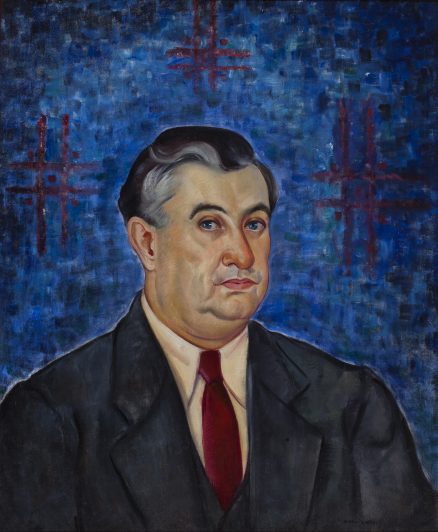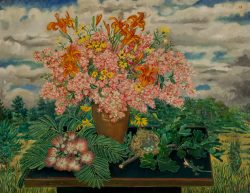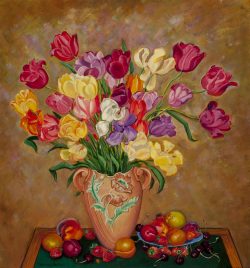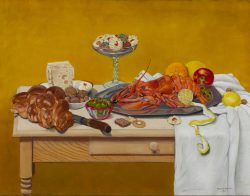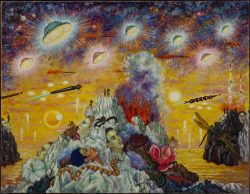Portrait of Clarence J. Bulliet
, circa 1935–1939Oil on canvas, 30⅛ by 24⅜ inches
- Categories
- Portraits
- Women artists
- Zoom in on Artwork
- Print Page
- Email Page to Friend
For her image of Clarence J. Bulliet, Macena Barton used a thoroughly conventional bust portrait format, showing the subject from the shoulders up and turned slightly to one side against a flat background. Formally attired in a dark suit, Bulliet gazes inscrutably at the viewer, the intense blue of his eyes echoed in the mottled color of the surrounding surface. As if to break up the void of the background, Barton enlivened it with patterned brushwork, lightened it around Bulliet’s head in a subtle halo effect, and superimposed on it three identical figures of intersecting lines and dots in red, matching the sitter’s tie.
The portrait gives no clue to the identity of its subject, whose appearance suggests a prosperous businessman or professional. In fact, C. J. Bulliet was an art critic whose relationship with Barton was perhaps the single most important of her career. Bulliet was born in Indiana in 1883 and worked as a journalist and theatrical promoter before turning to art criticism. Hired in 1922 by the Chicago Daily News, he soon became an influential champion of modernism in a city well known for its cultural conservatism. Barton was a rising young painter in 1931 when she asked Bulliet to write the catalogue introduction for her first solo exhibition, at Chicago’s Findlay Galleries. Claiming a “brilliant future” for Barton, Bulliet soon became her advisor and then her lover, although he was already married to landscape painter Katherine Adams Bulliet, who often showed in the same group exhibitions as Barton. Bulliet and Barton were an unlikely pair: she was petite, well-groomed, and stylish; Bulliet, nearly sixty when they met, was paunchy, walked with a limp, and had lost several teeth but refused to wear dentures. They shared a passion for books as well as art, and Bulliet promoted Barton shamelessly. Not until after Bulliet’s death in 1952 did she marry for the first time.
This is one of two portraits of Bulliet that Barton made. The better-known likeness (Union League Club of Chicago) dates to 1932 and refers pointedly to Bulliet’s relationship with the artist as well as to his published writings. In the two portraits Bulliet wears what appear to be the same dark suit and red tie, and he seems about the same age. However, this image lacks the expressive painted “halo” with which Barton often surrounded her subjects in portraits made between 1932 and 1935, suggesting it was made at a slightly later date. In contrast to the 1932 portrait, which Barton exhibited at the Art Institute of Chicago in 1932 and again in 1939, no record of exhibition of this portrait has come to light. Barton may have painted it for purely personal reasons.
Wendy Greenhouse, PhD
Donated by M. Christine Schwartz to the Newberry Library, Chicago, Illinois, in 2022
